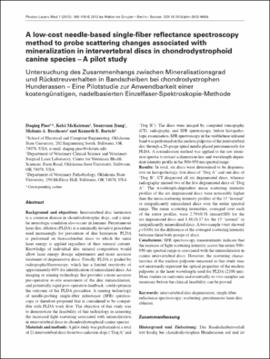| dc.contributor.author | Piao, Daqing | |
| dc.contributor.author | McKeirnan, Kelci | |
| dc.contributor.author | Jiang, Yuanyuan | |
| dc.contributor.author | Breshears, Melanie A. | |
| dc.contributor.author | Bartels, Kenneth E. | |
| dc.date.accessioned | 2023-07-06T21:39:02Z | |
| dc.date.available | 2023-07-06T21:39:02Z | |
| dc.date.issued | 2012-05-01 | |
| dc.identifier | oksd_piao_a_low_cost_needle_2012 | |
| dc.identifier.citation | Piao, D., McKeirnan, K., Jiang, Y., Breshears, M.A., Bartels, K.E. (2012). A low-cost needle-based single-fiber reflectance spectroscopy method to probe scattering changes associated with mineralization in intervertebral discs in chondrodystrophoid canine species - A pilot study. Photonics and Lasers in Medicine, 1(2), 103-115. https://doi.org/10.1515/plm-2012-0006 | |
| dc.identifier.issn | 2193-0635 | |
| dc.identifier.uri | https://hdl.handle.net/11244/337909 | |
| dc.description.abstract | Background and objectives: Intervertebral disc herniation is a common disease in chondrodystrophic dogs, and a similar neurologic condition also occurs in humans. Percutaneous laser disc ablation (PLDA) is a minimally invasive procedure used increasingly for prevention of disc herniation. PLDA is performed on thoracolumbar discs to which the same laser energy is applied regardless of their mineral content. Knowledge of individual disc mineral composition would allow laser energy dosage adjustments and more accurate treatment of degenerative discs. Usually, PLDA is guided by radiography/ fluoroscopy, which has a limited sensitivity of approximately 60 % for identification of mineralized discs. An imaging or sensing technology that provides a more accurate pre-operative in-situ assessment of the disc mineralization, and potentially rapid post-operative feedback, could optimize the outcome of the PLDA procedure. A sensing technology of needle-probing single-fiber reflectance (SFR) spectroscopy is therefore proposed that is considered to be compatible with PLDA work flow. The objective of this study was to demon strate the feasibility of this technology in assessing the increased light scattering associated with mineralization in intervertebral discs in chondrodystrophoid canine species. Materials and methods: A pilot study was performed on a total of 21 intervertebral discs from two cadaveric dogs ("Dog A" and "Dog B"). The discs were imaged by computed tomography (CT), radiography, and SFR spectroscopy, before histopathologic examination. SFR spectroscopy in the visible/near-infrared band was performed on the nucleus pulposus of the intervertebral disc through a 20-gauge spinal needle placed percutaneously for PLDA. A normalization method was applied to the raw remission spectra to extract a dimension-less and wavelength-dependent intensity profile in the 500 - 950 nm spectral range. Results: In total, six discs were determined to be degenerative on histopathology, five discs of "Dog A" and one disc of "Dog B". CT diagnosed all six degenerated discs, whereas radiography missed two of the five degenerated discs of " Dog A ". The wavelength-dependent mean scattering intensity profiles of the six degenerated discs were noticeably higher than the mean scattering intensity profiles of the 15 " normal " or insignificantly mineralized discs over the entire spectral range. The mean scattering intensities, averaged over each of the entire profiles, were 2.79 ± 0.58 (mean ± SD) for the six degenerated discs and 1.48 ± 0.37 for the 15 " normal " or insignificantly mineralized discs. A two-sample t -test showed p < 0.001 for the difference of the averaged scattering intensity between these both groups of discs. Conclusions: SFR spectroscopy measurements indicate that the increase of light scattering intensity across the entire 500 - 950 nm spectral range is associated with the mineralization in canine intervertebral discs. However, the scattering characteristics of the nucleus pulposus measured in this study may not necessarily represent the optical properties of the nucleus pulposus at the laser wavelength used for PLDA (2100 nm). More studies on cadaveric and eventually in-vivo samples are necessary before the clinical feasibility can be proved. | |
| dc.format | application/pdf | |
| dc.language | en_US | |
| dc.publisher | De Gruyter | |
| dc.relation.ispartof | Photonics and Lasers in Medicine, 1 (2) | |
| dc.rights | This material has been previously published. In the Oklahoma State University Library's institutional repository this version is made available through the open access principles and the terms of agreement/consent between the author(s) and the publisher. The permission policy on the use, reproduction or distribution of the material falls under fair use for educational, scholarship, and research purposes. Contact Digital Resources and Discovery Services at lib-dls@okstate.edu or 405-744-9161 for further information. | |
| dc.title | A low-cost needle-based single-fiber reflectance spectroscopy method to probe scattering changes associated with mineralization in intervertebral discs in chondrodystrophoid canine species - A pilot study | |
| dc.date.updated | 2023-07-02T13:44:01Z | |
| dc.identifier.doi | 10.1515/plm-2012-0006 | |
| dc.description.department | Electrical and Computer Engineering | |
| dc.description.department | Veterinary Clinical Sciences | |
| dc.type.genre | Article | |
| dc.type.material | Text | |
| dc.subject.keywords | veterinary sciences | |
| dc.subject.keywords | agricultural, veterinary and food sciences | |
| dc.subject.keywords | engineering | |
| dc.identifier.author | ORCID: 0000-0003-0922-6885 (Piao, D) | |
| dc.identifier.author | ScopusID: 7005153312 | 57220465193 (Piao, D) | |
| dc.identifier.author | ResearcherID: I-1341-2013 (Piao, D) | |
| dc.identifier.author | ScopusID: 37088992300 (McKeirnan, K) | |
| dc.identifier.author | ScopusID: 55826731200 (Jiang, Y) | |
| dc.identifier.author | ScopusID: 6506721660 (Breshears, MA) | |
| dc.identifier.author | ScopusID: 7005400149 (Bartels, KE) | |
| dc.identifier.essn | 2193-0643 | |
